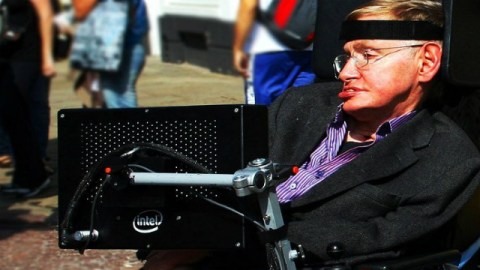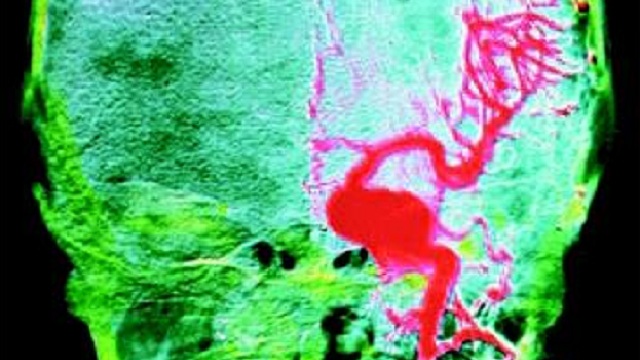Hacking Hawking’s Brain

The buzz surrounding physicist Stephen Hawking‘s newest experiments with communication technology has been a bit overexuberant, along the lines of “new technology could help Stephen Hawking communicate via brain waves!” Let’s back up a little.
The iBrain Hawking has been wearing is a small, convenient brain monitor worn in a headband. It’s a significant advance over other brainwave monitors in that it a) doesn’t require an overnight stay in a facility and b) comes closer than other such devices to isolating intent – that is, identifying specific patterns in brain wave activity which might eventually enable scientists to decode and machine-translate the specific word a person has in mind. This is a step closer to opening a world of mind-reading and telekinetic technologies.
For Hawking, communicating via thought would obviously be an enormous improvement over the laborious process he now uses to write emails and books – twitching his cheek muscles to select words, one by one, on a computer screen. Hawking has lived and worked for 50 years with Amyotrophic Lateral Sclerosis, or ALS – a degenerative motor neuron disease that leads to paralysis and death, usually within five years of diagnosis.
There is no indication from any available source (including Hawking himself) that Hawking is doing anything more with the iBrain at the moment than helping Neurovigil, its manufacturer, to refine the technology and their ability to read brainwaves through it. The possibility that Hawking will ever use it as a seamless communication tool seems remote.
Still, the research is promising, and should advance the science that will eventually make such tools a reality. And Hawking’s eagerness to participate for the sake of science and the benefit of others, like himself, who suffer debilitating paralysis, is inspiring. This is especially so considering that his health and his ability to communicate have been steadily deteriorating since he suffered an ALS-related stroke in 2009.
“My advice to other disabled people would be, concentrate on things your disability doesn’t prevent you doing well, and don’t regret the things it interferes with. Don’t be disabled in spirit, as well as physically.”
– Stephen Hawking
Based on the timeline below, where would you rank these current research efforts among Hawking’s lifetime accomplishments?
A Brief History of Stephen Hawking
Jan 8 1942
Born in Oxford, England.
1953 to 1958
Attends St Albans school in North London, and becomes fascinated with mathematics.
1959 to 1962
Specialises in physics at University College Oxford. Graduates with a first class degree in natural sciences.
1963
Begins research in cosmology and general relativity at the University of Cambridge. Diagnosed with ALS.
1970
Discovers a remarkable property: by using quantum theory and general relativity he is able to show that black holes can emit radiation.
1973
Joins the department of applied mathematics and theoretical physics at Cambridge.
In the same year he discovers, to his disbelief, that black holes could leak energy and particles into space, and even explode in a fountain of high-energy sparks.
1974
His breakthrough discovery is published in the journal Nature, in a paper entitled Black Hole Explosion?
1979
Appointed Lucasian professor of mathematics at Cambridge (a chair held by Sir Isaac Newton in 1663). Elected as a fellow of the Royal Society.
1988
Publishes A Brief History of Time: From the Big Bang to Black Holes, a classic introduction to today’s most important scientific ideas about the cosmos. Recorded in the 1998 Guinness Book of Records as an all-time bestseller.
1993
Publishes Black Holes and Baby Universes, and other Essays, a collection of scientific articles exploring ways in which the universe may be governed.
1998
Publishes Stephen Hawking’s Universe: The Cosmos Explained, a book about the basis of our existence and of everything around us.
2001
Releases Universe in a Nutshell in the UK, a book that unravels the mysteries of recent breakthroughs in physics.
2002
Releases On the Shoulders of Giants, The Great Works of Physics and Astronomy, an exploration of some of the greatest visionaries in the history of science including Copernicus, Kepler, Galileo, Newton and Einstein.
Publishes The Theory of Everything: The Origin and Fate of the Universe, a book that presents the most complex theories of physics past and present.
2004
Hawking announces that he has solved the Black Hole paradox, which has been a troubling scientists for years. He presents his most recent findings at the international conference on general relativity and gravitation in Dublin.
2005
Publishes God Created the Integers and A Briefer History of Time
2007
A statue of Hawking by renowned late artist Ian Walters is unveiled at the Centre for Theoretical Cosmology, University of Cambridge.
2009
Awarded the Presidential Medal of Freedom, the highest civilian honor in the United States.
2012
Participates in experimental research on iBrain, a brain wave monitor which may eventually enable thought-based communication.





